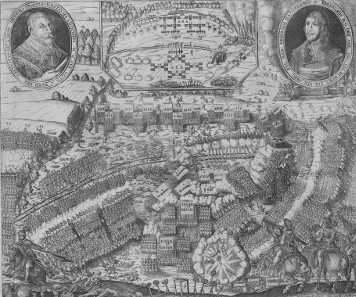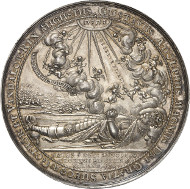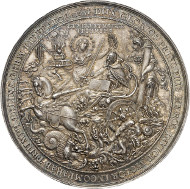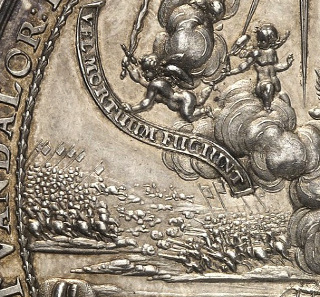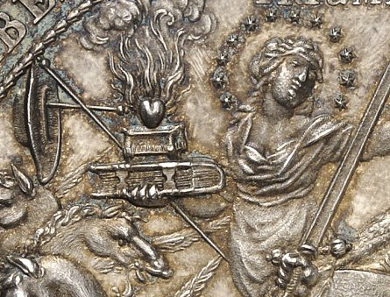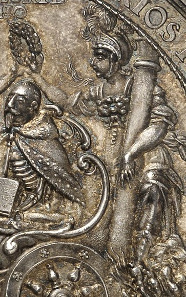Strictly speaking, the year was much too advanced to enter a battle, for the date was 16 November 1632. But the Thirty Years’ War had changed all military habits. The goal was rather to prevent the imperial army, commanded by Wallenstein, from putting a bolt between the Saxon and the Swedish troops.
Practically, the great war had already been won by the Protestants. With his intervention, the Swedish king Gustavus II Adolphus had changed the situation for the better. Thus, the German believers in the Protestant faith welcomed him like a liberator. In September 1631, the lion from the north had routed the imperial army under Tilly near Breitenfeld. The old military commander couldn’t cope with the linear formation of the Swedish army. He was likewise defeated near Rain in April 1632. As a result, the Swedish had access to entire southern Germany. It was left to Wallenstein – whom the emperor had to call back – to at least slow down the advance of Gustavus Adolphus. And then, near Lützen, the two most ingenious military leaders of their time, finally met.
A contemporary image of the battle of Lützen.
Wallenstein was at a disadvantage. Parts of his army had already departed for their winter quarters and hence had to be ordered back again. When the fog lifted at about eleven a. m., Wallenstein faced a superior enemy. Gustavus Adolphus conducted the first attack himself. He scattered the enemy center. It seemed that after just one hour the Protestants had already won the battle, but then the imperial forces managed to regroup thanks to the arrival of fresh troops. Consequently, the west wing of the Swedes was in desperate straits. Gustavus Adolphus got to the rescue when an anonymous soldier fired a shot on him that smashed his arm. Another shot hit the king in the back. He fell off his horse but got caught in the stirrup so that his body – he was still alive at that time – was dragged over the battle field. Only a stab with an armor-piercing sword put an end to his life. According to the traditional soldier’s custom, the disfigured body was looted and left naked on the ground. The dead king got its dignity back thanks to the skills of apothecary Kaspar König who laid him out and embalmed him in order to prepare him to be transferred to Sweden.
On March 13, 2014, in Künker auction sale 247, a silver medal created by Sebastian Dadler on the funeral of the Swedish King Gustavus II Adolphus at Riddarholm Church will be available for sale. The perfectly preserved showpiece, which is now part of the Baums collection, comes from the Hagander Collection and is estimated at 4,000 euros.
After all, the lion from the north was to be transported back into his native country in a lavish, propagandistically exploited funeral cortège. That is exactly the subject – at least on an allegorical level – of the medal Sebastian Dadler created on the occasion of the king’s funeral at Riddarholm Church on 22 June 1634. You have to look closer at this fantastic piece to understand every single reference the artist has hidden in the depiction:
Unwounded and without any visible sign of death, the king rests, fully armored and with the crown on his head, on his deathbed on the obverse of the medal. He has just sighed out his soul that is carried towards the sun by a little choir of putti. In the sun disc we find the name of God inscribed, and God calls the deceased hero home with the words: Well Done, Faithful Servant.
In the background the battlefield is depicted. The Swedes put the imperial troops to rout. That seemed like a miracle to the contemporaries because, strictly speaking, a battle was considered lost once the commander had died. Near Lützen, however, the Swedes held their ground, and that is the backdrop for the inscription on the banner: Even the Death they flee.
The reverse depicts the triumphal procession of the victor. He sits in a triumphal chariot pulled by three galloping horses that is decorated by lion masks and tramples the Whore of Babylon and her riding animal, the seven-headed beast. The Protestants identified the Whore of Bablyon with the Roman Catholic Church.
Her counterpart was the Woman of the Apocalypse with a crown of stars on her head. She embodies the Protestant Church and, as symbol of her true faith, she holds a bunch of symbols in her right hand. Right at the very bottom, we see a book closed. On top stands an altar with a heart burning. Dadler took these images from an emblemata book by Daniel Cramer, which he often used as reference. In the Emblemata Sacra, the heart burning on the altar stands for the love to God while the heart on the book represents scriptural knowledge. To put it another way: that small detail in the illustration conveys one of the most essential Protestant claims: Sola Scriptura (= By Scripture Alone). This image is crowned by a cap of liberty which the Dutch provinces used first, as symbol of their independence, but which soon became a symbol for the liberty of all Protestants.
This incarnation of the Protestant Church puts a crown on her successful protagonist Gustavus Adolphus together with the cardinal virtue Fortitudo with her column, representing courage.
Gustavus Adolphus is shown in a Christ-like iconography in that he holds an open book in his left hand. There, it can be read: The Word of God is Eternal. The entire left arm, where the shot had hit him, already belongs to the realm of the dead; it is sceletonized while the right arm is still powerful and holds the sword of the religious warrior. ET VIVA ET MORTE TRIUMPHO – I Triumph in Life as well as in Death, reads the inscription above the illustration.
Actually, the king’s death didn’t affect the military situation in Germany to a great extent. Axel Oxenstierna carried on the policy of his king on behalf of five year-old queen Christina; and the war took another 16 years.
You can find an auction preview here.
The complete auction catalogue is available on the Künker website.




